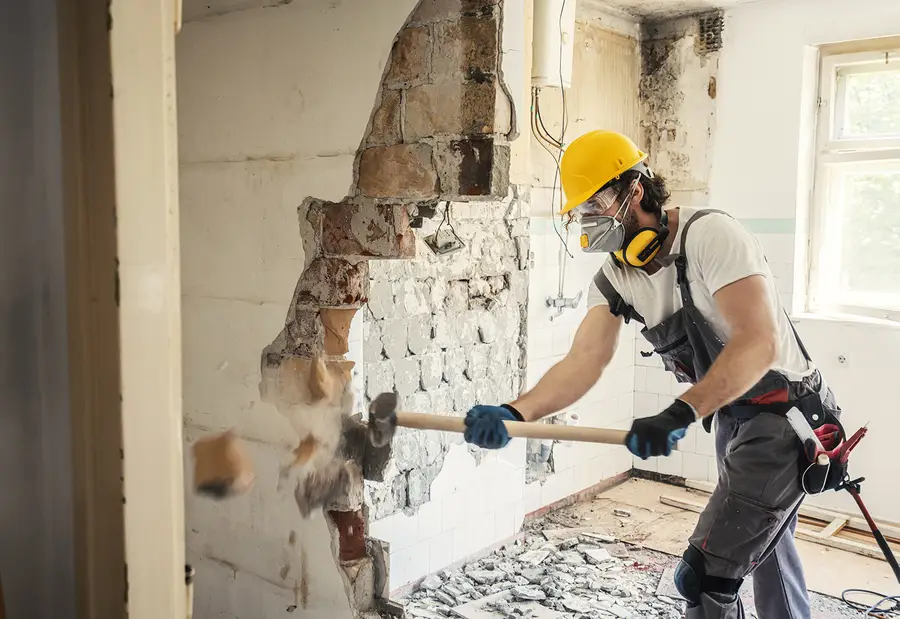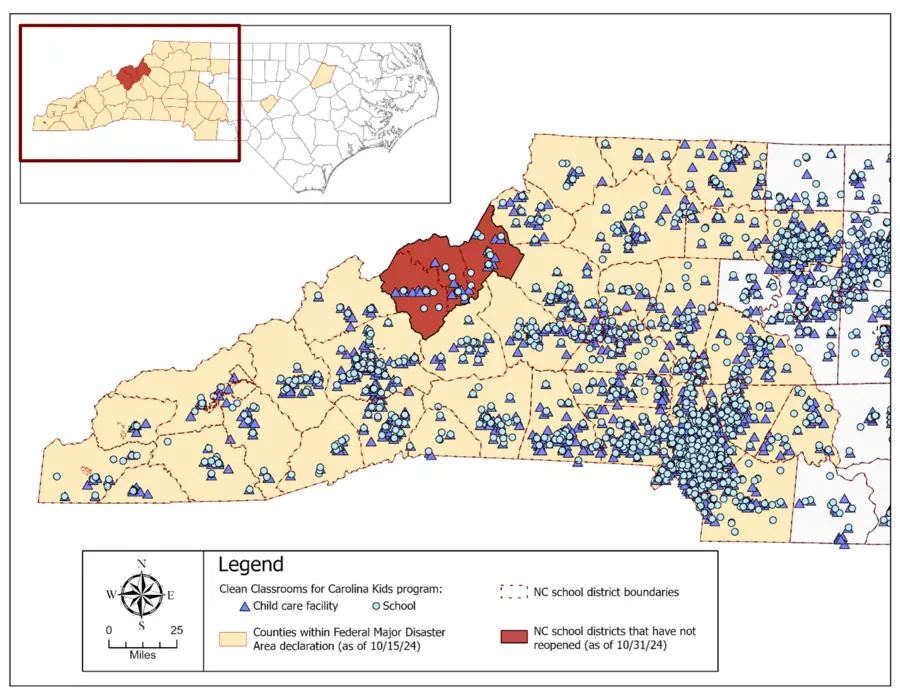
At the end of September 2024, Hurricane Helene delivered torrential rainfall to Western North Carolina and caused severe flooding and record-high river levels, bringing damage to infrastructure, residential and commercial buildings, and roads . The area’s mountainous terrain exacerbated the flooding and complicated relief efforts. As impacted communities come together to clean up and rebuild, schools and child care facilities – essential for children’s development – face significant challenges in reopening, affecting their operations, staff, students, and buildings.
Rebuilding a Community Safely: A View on Schools and Child Care Facilities in NC
The Clean Classrooms for Carolina Kids program, administered by RTI International, partners with public and charter schools as well as licensed child care centers and family child care homes throughout North Carolina to identify and eliminate lead and asbestos hazards in child-occupied buildings. Over 200 child care facilities and 35 school districts in Western North Carolina were affected by the storm, with 55 child care centers suffering major damage and 3 school districts still closed as of October 31, 2024 [Figure 1]. Safe work practices during debris clean up and renovations will be necessary in the restoration of communities, particularly in schools and child care facilities where children learn and play.
The Clean Classrooms for Carolina Kids team is working alongside impacted facilities to provide information on safe post-disaster work tips and steps to utilize state and federal funds and resources as they recover from Hurricane Helene. We recognize the devastating impact of Hurricane Helene, and we are dedicated to assisting facilities in providing healthy learning environments for children. We aim for our team to be a helpful resource across schools and child care facilities in Western North Carolina as communities rebuild so that all children can return to a safe environment while receiving a quality education.

Figure 1. Child care facilities and public schools in counties with a disaster declaration and areas not reopened (as of October 31, 2024).
Lead and Asbestos in NC Schools
Lead and asbestos hazards pose significant public health concerns in the aftermath of natural disasters, including hurricanes. Buildings such as schools and child care centers, as well as family child care homes, often experience difficulty returning to normal operations due to power outages, lack of clean drinking water, and structural damage to buildings. Common renovation activities like removing damaged building materials, sanding damaged surfaces, and demolition can disturb lead-based paint and asbestos-containing materials, creating exposure hazards. Children in the physical proximity of cleanup activities are especially at risk, as they can inhale lead dust and asbestos fibers or ingest them by touching contaminated surfaces and then putting their hands in their mouths. It is crucial for schools and child care facilities to implement safe work practices to reduce exposures, particularly in older buildings that need repairs.
Lead-based paint, commonly used in buildings prior to the ban of its residential use in 1978, is known to have toxic health effects. It can be found on both interior and exterior surfaces, including walls, windows, doors, stairs, and porches. When lead-based paint deteriorates or is damaged (peeling, chipping, chalking, cracking, etc.), or when elevated levels of lead dust are present, these conditions are classified as hazards. When lead is absorbed into the body, it damages the brain and other vital organs and can cause lifelong behavioral and cognitive deficits.
All About Lead-Based Paint Regulations: In North Carolina, the Department of Health and Human Services (NC DHHS), Division of Public Health, Health Hazards Control Unit (HHCU) operates two Lead-Based Paint Hazard Management Programs in lieu of the United States Environmental Protection Agency (EPA). The first program (LHMP) is for abatement activities, i.e., measures that are designed to eliminate lead-based paint and lead-based paint hazards as a long-term response. Facilities pursuing abatement projects will need to use lead certified individuals, obtain a permit from HHCU, and conduct clearance testing. The second program (LHMP-RRP) is in accordance with the EPA Renovation, Repair, and Painting (RRP) Rules that are in place to reduce exposure to lead-based paint hazards during renovation, remodeling, and painting activities. Contractors working on projects that may disturb painted surfaces in homes and child-occupied facilities built before 1978, including child care facilities and schools, must be certified and adhere to lead-safe work practices. For any facilities with urgent safety hazards after the hurricane, weather-based emergency renovations are exempt from certain requirements under the emergency provision of the RRP Rule, such as the warning sign, containment, and certification requirements, until the necessary actions to address the hazards have been completed. Facilities should ensure that proper cleaning and recordkeeping actions are still taken to minimize childhood exposure to lead-based paint hazards following any RRP projects.
Asbestos is a general term used to refer to a group of naturally occurring minerals that is resistant to heat and corrosion and is commonly found in pre-1990 building materials like insulation, textured ceilings, floor tiles and adhesives, fiber-reinforced cement siding, roofing, and woven materials like fireproof curtains and gaskets. While asbestos does not pose a hazard when in good condition, damage or disturbance (such as in the case of post-disaster cleanup, renovations, or repairs) can cause the release of asbestos fibers into the air. If inhaled, these fibers can become trapped in the lungs or migrate to other areas of the body, leading to mesothelioma, lung cancer, or other cancers.
All About Asbestos Regulations: For renovation and demolition activities, facilities are required to inspect their buildings for asbestos-containing materials under the National Emission Standards for Hazardous Air Pollutants (NESHAP) Asbestos Regulations. HHCU manages the Asbestos Hazard Management Program (AHMP) that oversees asbestos management activities, like asbestos inspections, accreditation, abatement, and air monitoring, as well as the NESHAP Program for North Carolina (except for Forsyth, Buncombe, and Mecklenburg counties, which have their own local programs). Facilities should perform work in accordance with NESHAP regulations and submit a notification to HHCU prior to any demolition or renovation activities. Individuals handling asbestos-containing materials after the hurricane should follow the Occupational Safety and Health Administration (OSHA) Regulations for asbestos to ensure safety during renovations and repair work.
As schools and child care facilities are cleaning up, repairing, renovating, and rebuilding after the hurricane, it is critical to follow established safety guidelines and regulations to protect personal and public health for all students, staff, and workers.
Safety Tips for Post-Hurricane Helene Clean-Up for Schools and Child Care Facilities
Early childhood exposure to lead and asbestos is a public health concern and can cause behavioral and cognitive deficits and physical disability or disease later in life, so it is important to follow safe work practices during renovation and rebuilding activities in child-occupied facilities. Facilities should engage a certified lead and/or accredited asbestos professional to complete work with any known or suspected lead or asbestos in buildings. Facilities should follow HHCU’s lead-based paint requirements for abatement and renovation activities and asbestos requirements for renovation and demolition activities.
At minimum, the following recommended procedures should be used when cleaning up after the hurricane to protect students and staff from lead-based paint and asbestos:
- Use the proper personal protective equipment (PPE) prior to entering areas that may contain lead-based paint or asbestos.
- Avoid smoking, eating, or drinking in the work area.
- Keep children, pregnant people, and animals away from the work area until all activities are complete and the area is cleaned.
- Clean dust and debris with a High Efficiency Particulate Air (HEPA) vacuum and use sanders or grinders with a HEPA vacuum attachment to minimize the amount of lead dust and asbestos fibers in the air.
- Use risk minimizing techniques like wet sanding or scraping for any surfaces with lead-based paint to generate less lead dust and reduce the release of asbestos fibers into the air.
- Ensure safe handling and disposal of all waste and debris in a designated and approved landfill or waste disposal area.
Support for Schools and Child Care Facilities in the Wake of Helene
Renovations and abatement work can be costly in the aftermath of a natural disaster, and many schools and child care facilities already have limited funding. As schools and child care facilities are preparing for reoccupancy, they can utilize federal funds that are allocated to address lead and asbestos hazards.
Resources for Testing and Mitigation: The Clean Classrooms for Carolina Kids program provides lead-based paint risk assessments and asbestos inspections to public schools and licensed child care facilities at no cost to facilities, with enrollment information at www.cleanwaterforuskids.org/carolina. Schools or child care facilities with identified lead-based paint or asbestos-containing materials can also apply for reimbursement for mitigation/abatement activities from the NC Department of Health and Human Services (DHHS) Health Hazards Control Unit. Mitigation/abatement costs are reimbursable up to two-thirds for public and charter schools, and fully reimbursable for licensed child care facilities for eligible expenses. Eligible expenses include asbestos and lead-based paint abatement and renovation activities and replacement materials.
Resources for Returning to Operations: In addition to the available mitigation/abatement funds, DHHS is supporting child care facilities to reopen or continue operating with disaster flexibilities. Child care facilities can work with their licensing consultant to develop an Emergency Operations Plan so that they can reopen their doors to children and families in their communities with considerations of both flexibility and safety guidance.
